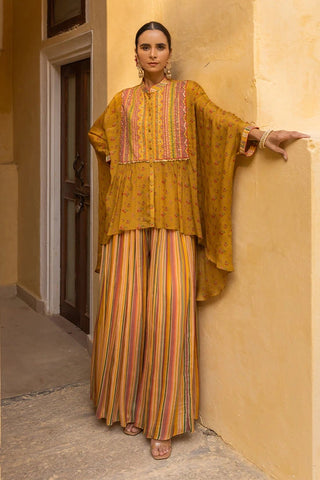Introduction
When it comes to sharara vs. palazzo, it depends upon the choice of the wearer and the occasion. It is only natural to get easily confused between a sharara and a palazzo. Those who have already experienced the glamour of both might be able to differentiate between the two.
Both sharara and palazzo are able to radiate their own charm. You can wear them on various occasions depending upon the overall look and style you want to showcase. Now if you want to know the differences between the two, let's first understand the sharara and palazzo. Then we can move on with the differences and similarities between them along with their styling options.
Understanding the sharara and palazzo

Sharara is a traditional outfit that has its roots in the Mughal era. While the palazzo came into existence in the 1960s and was worn by women who adored Avant-garde fashion.
Sharara can be looked at as a traditional outfit but is also known to have seen many developing fashion trends. It is a set of flared pants that is loose around the legs and has an impressive flare. Many times the flare often confuses some women with the concept of sharara and gharara. You could easily find a sharara that has both traditional and contemporary elements.
As for palazzo, they came from a modern fashion trend. They are a set of wide-leg pants with a flare that spreads out evenly from the waist to the ankle. The comfort offered by palazzo pants made it a popular choice in traditional outfits as well. This is why you can also find a variety of palazzo suits in Indian fashion.
Difference between sharara and palazzo

You have already seen the cultural difference between sharara and palazzo in the above text. Other than that, there are many other key differences that can help you choose between sharara vs. palazzo.
Length
The length of the sharara is shorter as compared to the palazzo. The palazzo pants are of a long length that touches the floor whereas the sharara length usually covers your ankle.
Waistband
Sharara has a tight-fitting waistband and an amazing flared silhouette. Whereas the waistband of the palazzo is wide and has an overall loose fitting. Here, even the fit of the waistband helps to highlight the flare of both outfits.
Fabric
Sharara is often made of lightweight fabric that can give a great flow such as chiffon, georgette, crepe, satin, and more. However, palazzo can be made from a variety of fabrics like silk, cotton, jersey, leather, and more.
Comfort
The palazzo is of loose fitting with manageable flare which makes it a comfortable choice for many. Whereas, the sharara has a lot of flare that can make it uncomfortable if you are into physical activities.
Versatility
Most of the time sharara is worn at traditional events, formal events, and festivities. As for the palazzo, it can be worn on various occasions due to its trendy styles.
Similarities between sharara and palazzo

They both look different from one another, but still, you can spot some similarities between sharara and palazzo. Some of them are as follows:
- Sharara and palazzo both have wider bottoms and are of loose fitting which makes them comfortable.
- Lightweight fabric such as silk, satin, chiffon etc. can be used for both sharara and palazzo to enhance elegance and create flow.
- Sharara is worn as a traditional outfit and you can even choose a palazzo for traditional wear due to trendy styling.
- You can easily pair a sharara and palazzo with versatile styling options like kurtis, tunics, shirts, and structured tops.
Styling considerations
Styling a sharara and palazzo can be interesting due to the versatility and latest trends that give them timeless allure. These are some of the styling considerations that you may want to look at to style your sharara or palazzo:
Styling a palazzo
- You can select any colour, print and pattern for palazzo depending upon your mood and occasion.
- Pair it with Kurtis and tunics for a relaxed look or crop tops, structured tops, or tucked-in shirts for a modern look.
- Long jackets and shrugs with embroidery or embellishments with a wider palazzo and embroidered kurti for a traditional look.
- Layer the palazzo with blazer, leather or denim jackets and printed jackets or shrugs for a casual look.
- Accessorise with heels or wedges if the palazzo covers the shoes or go for flats and sandals for a casual look.
- Use a belt to define the waistline for a high-waist palazzo, statement jewellery for a bold look, and a scarf for elegance.
Styling a sharara
- Pair it with a kurti, peplum, crop top, satin shirt, or jacket as per your personal choice.
- Drape the dupatta like a saree or in any traditional or modern style depending upon the occasion.
- The fabric, embroidery, and embellishment of your top should complement your sharara.
- If you want a traditional look, opt for jhumkas, bangles and maang tikka. Similarly, pick statement jewellery for a bold look and sleek and delicate jewellery for a minimalist look.
- Carry a clutch or potli with embellishments, floral patterns, or textured fabric depending upon your outfit.
- Heel and wedges work great for a modern look whereas embroidered mojaris and wedges can create a great ethnic look.
Final thoughts
Sharara and Palazzo come from different cultural backgrounds. However, due to numerous trends and versatile styling options, they can give both a traditional and casual look. When it comes to sharara vs. palazzo, the key differences in their waist, flare, and comfort can help you make your choice. You will also find similarities between them even though they look different. Additionally, the styling options will help you carry the outfit as per your desired look.



